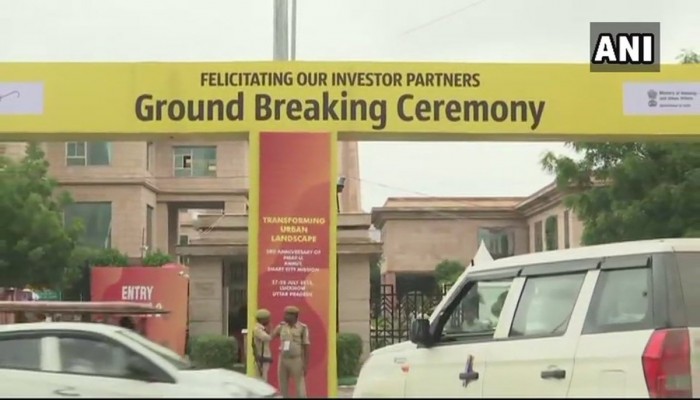The Uttar Pradesh Growth Story
- In Current Affairs
- 05:55 PM, Dec 11, 2020
- Abhishek Dwivedi
Recently, it was reported that the Uttar Pradesh government has allotted 1100 plots of land to companies since the COVID-19 pandemic which is expected to generate an investment of INR 9700 crores. The promptness is a reflection of Yogi Adityanath government’s determined efforts to compete with already established and preferred destinations of investments such as Tamil Nadu, Gujarat and Maharashtra.
In last few years, Uttar Pradesh has seen tremendous progress in terms of big-ticket public infrastructure projects, air connectivity, medical facilities and smart urban transport projects. And the government is in no mood to slow down the pace at which these projects are being announced and commissioned. For instance, the land acquisition process for the Ganga Expressway announced at Kumbh last year, has already commenced and work is likely to begin by mid next year. The concession agreement for the long pending Jewar Airport at Noida has also been signed. Projects are being executed on mission-mode and carry tremendous potential for industrial development of the state, when executed.
In recent years, Uttar Pradesh has become home to big ticket infrastructure projects. The erstwhile Akhilesh Yadav government had commissioned the Agra-Lucknow expressway project connecting Agra to Lucknow through a 302.22 km long access-controlled expressway. It was a first of its kind project and coupled with Lucknow metro, constituted the two big projects executed by the Akhilesh government. The real push however came after Yogi Adityanath became the Chief Minister of Uttar Pradesh. When Yogi government took over, it realized that there can be no distributed development of Uttar Pradesh; and industrial development will be localized to National Capital Region (NCR) unless connectivity is improved in the entire state. Since then, the Yogi government has commenced work on five brand new expressways, metros in three cities, two large airports (Jewar and Ayodhya) and 15 small-scale (Udaan) airports, the Defense Corridor and 15 new medical colleges.
First of these, the Purvanchal Expressway will connect Ghazipur, in the Purvanchal region to the state capital, Lucknow. The 340 km long access-controlled expressway, being constructed through the Uttar Pradesh Expressway Industrial Development Authority (UPEIDA), will cost the state exchequer INR 22,494.66 crores and the entire project has been divided into eight packages. As of September 2020, 57.27% of work has been completed and the Government is planning to open the Expressway to public by early 2021. The expressway will pass through Barabanki, Sultanpur, Amethi, Ayodhya, Azamgarh and Mau. The Yogi government plans to develop industrial corridors and manufacturing clusters along the expressway.
The Purvanchal Expressway will be linked to Gorakhpur, the home to Shri Gorakhnath Dham, vide the Gorakhpur Link Expressway starting from Gorakhpur and meeting the Purvanchal Expressway in Azamgarh, covering a distance of 91.3 Kms. The project is expected to cost the Yogi government approximately INR 5876.67 crores. The expressway, once completed, will also pass through Sant Kabeer Nagar and Ambedkar Nagar. Around 90% of the land has already been acquired and final EPC contracts have been executed. As on November 2020, 5% of the work has already been completed.
The most important project of Yogi government is the Bundelkhand Expressway that will pass through the financially and industrially underprivileged Bundelkhand region. Since 2014, the Prime Minister has repeatedly stressed on bringing development to the Bundelkhand region and this Expressway is aligned with his focus on the region. The 296 km long access-controlled expressway will start from the historical district of Chitrakoot and merge with the Agra-Lucknow Expressway near Etawah, connecting the Bundelkhand region with NCR. The INR 7766 crore Project has been awarded to four firms in six packages. As of September 2020, 16% of the work has been completed and the work is being done on a mission mode.
In Kumbh 2019, the Yogi government announced its intention to build Ganga Expressway which was to trace the route of Ganga and link Meerut to Prayagraj. A 594-km access-controlled project, the Ganga Expressway will link 12 agricultural districts of Uttar Pradesh and eventually will be extended to meet the Balia Link Expressway. The feasibility studies have been completed and the project will be tendered in coming days in 12 packages. The project is likely to cost INR 36,402 crores for the first phase and the government has roped in SBI Market Capitals as the financial advisor for the project. The government is keen to have foreign investment in the project and initial feelers are being sent to foreign investors as of now. The land acquisition process is likely to begin this year itself with actual work commencing in mid-2021.
The Yogi government has also cleared the construction of Balia Link Expressway that will connect the Balia District at the Uttar Pradesh-Bihar border with the Purvanchal Expressway. The project is likely to cost INR 1600 crores. As of now, the detailed project report is being prepared.
When completed, these expressways are expected to have a total length of 1900 km. What makes these expressways crucial, is the fact that large-scale plug and play industrial infrastructure is being developed along these expressways. These industrial land banks and infrastructure are complemented by the renewed industrial policies, as listed below. Such expressways, interlinked with each other, will cover almost all the crucial agricultural, industrial and tourism districts of Uttar Pradesh.
Other than expressways, one of the most important industrial project in Uttar Pradesh is the establishment of a Defence Corridor. Located alongside the Bundelkhand Expressway and the Agra-Lucknow Expressway, the project will have Lucknow, Aligarh, Jhansi, Chitrakoot and Kanpur as its central nodes. Jhansi will have the largest land bank contribution to the project and a total of 3788 hectares of land is proposed to be acquired for the corridor. The government is establishing a Defence Park in Kanpur, an artillery firing range in Jhansi and a CFC in Lucknow under the said project. Once fully operational, the Defence Corridor is likely to bring 2,50,000 jobs to Uttar Pradesh other than contributing immensely to local development. Chief minister Yogi Adityanath recently met the top executives of the leading defence companies including L&T Defence, Mahindra Defence, Hinduja Group and Siemens to push for investments in the Defence Corridor. As of now, 1217 hectares of land has already been acquired and more than 50 memorandum of understanding(s) have been signed for establishment of facilities in the corridor. French defence company Thales recently announced that it will collaborate with Kanpur based MKU to manufacture night vision equipment for Indian armed forces under the Defence Corridor project.
Another crucial project by the government is a much-delayed Jewar Airport. It is proposed to be constructed in Noida and will be 72 kms from the Indira Gandhi International Airport in Delhi. Other than sharing the burden of the Delhi Airport, the Yogi government plans for this airport to be a logistics hub with dedicated runways and hangars for commercial logistics and goods. The acquisition of 1,334 hectares of land for Phase-1 has been completed and the concession agreement with Zurich Airport AG has been signed in October 2020. Construction work for Phase-1 will commence from February 2021 and land acquisition for Phase-2 is likely to commence soon. The airport is likely to commence operations in 2023-24. The airport is being planned in four phrases and when complete, will have six runaways along with dedicated transport hubs and commercial centres.
The Yogi government has also cleared a brand new International Airport at Ayodhya to be called Maryada Purshottam Shri Ram Airport, Ayodhya. The airport will be developed on an existing airstrip and additional land is being acquired to have a 45m wide airstrip along with associated facilities. The airport will be spread around 600 acres and is likely to commence operations in 2024.
Further, the Kushinagar Airport has also been converted into an International Airport with operations likely to commence soon. The Uttar Pradesh government, in close coordination with Airports Authority of India, is planning to develop Udaan airports in each of the 18 divisions of Uttar Pradesh. Development works has already commenced for 15 of these 18 divisions, and feasibility studies are being conducted in the others. These include Meerut, Bareilly, Jhansi, Chitrakoot and Aligarh. The government is also seeking to upgrade several World War-II era airstrips to make them accessible for small commercial operations.
Other than the large-scale public infrastructure projects, the government is also focusing heavily on upgrading the medical facilities across the state. In last three years, the government has sanctioned construction of 15 new medical colleges. All the district hospitals with more than 200 beds capacity are being converted into medical colleges. Yogi Adityanath’s dream project- AIIMS Gorakhpur has started functioning, becoming the second AIIMS in the state after AIIMS Raibareilly. The government has also established the Shri. Atal Bihari Vajpayee Medical University at Lucknow which will act as the parent university for all medical colleges in Uttar Pradesh. Around 50 acres of land has been allotted to the university and the construction is likely to be completed within 2 years.
Coming to urban transport, as of now, only Noida, Ghaziabad and Lucknow have operational metro systems. Yogi government, since taking over in 2017, has declared its intention to have metros in Varanasi, Jhansi, Kanpur, Gorakhpur, Meerut, Agra and Prayagraj. As of now, construction work is ongoing in Kanpur and Agra, while Gorakhpur has recently received the sanction for Metrolite. The Lucknow Metro Rail Corporation (LMRC) has already been renamed by the government as Uttar Pradesh Metro Rail Corporation and has been tasked with preparing and implementing metro projects in these districts. The Yogi government has also placed utmost faith in electric mobility and released the Electric Vehicle Manufacturing and Mobility Policy in 2019 to promote usage and manufacturing of e-vehicles. It has planned 650 electric buses for 13 districts and tenders for charging stations has been recently announced. In fact, the government is planning to commence operations for electric cars for tourists in cities like Jhansi and Prayagraj.
The government has also released a slew of new policies to improve the ease of doing of business in the state, being the Uttar Pradesh Start-up Policy 2020, Electric Vehicle Manufacturing and Mobility Policy in 2019, Uttar Pradesh Solar Policy 2019, etc. These policies are in addition to the comprehensive polices issued in 2018 regarding dairy, defence and warehousing. The government has also amended the Uttar Pradesh Industrial Policy 2017 to enhance the incentives available to investors investing in Bundelkhand and Purvanchal regions of Uttar Pradesh. These policies, coupled with the government’s focus on large scale infrastructure projects has propelled Uttar Pradesh to second rank in the recent ease of doing business rankings.
While the Yogi Government is making all the right moves, it remains to be seen whether these initiatives and projects are able to offset the rural unemployment problem that COVID-19 induced reverse migration has caused. While a slew of a new investments have been announced, they do pale in comparison to Tamil Nadu and Gujarat. It may be the case that investors are waiting for these projects to take shape before investing in Uttar Pradesh. Only time will tell whether the Yogi government is able to sustain the momentum and make Uttar Pradesh a manufacturing and industrial hub.
Image Credit: ANI







Comments